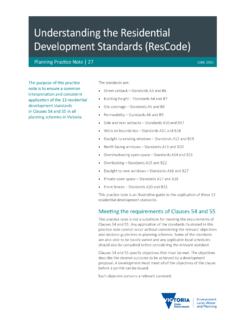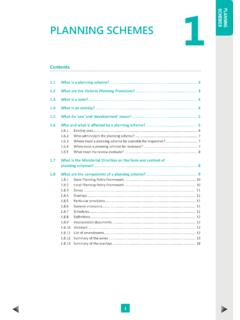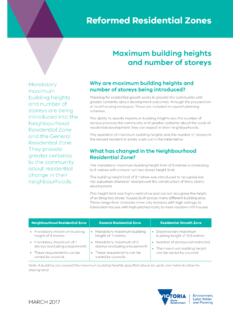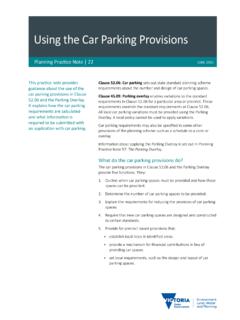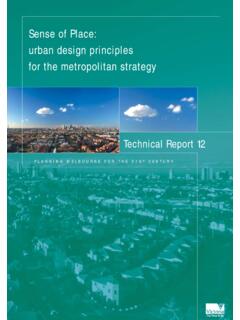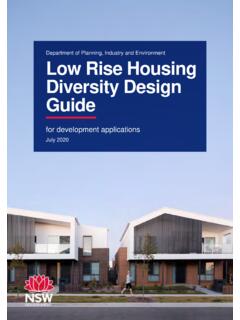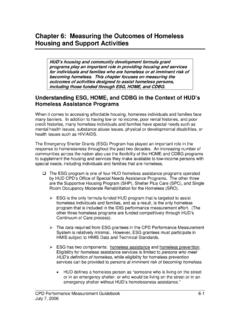Transcription of Applying the Rural Zones - Planning
1 The suite of Rural Zones for VictoriaThe Rural areas of Victoria accommodate a range of farming, residential and commercial uses and contain many of the state s significant natural resources, such as native vegetation, minerals and water. They also provide important resources for recreation, tourism and timber production. The suite of Rural Zones for Victoria: recognise the state, regional and local importance of farming as an industry and provide greater protection for productive agricultural land provide a wide choice of Zones with clear purposes and controls to match discourage ad hoc and incompatible use and development recognise the changing nature of farming and reduce the potential for conflict between farming and other land uses recognise that Rural areas are places where people live and work recognise and protect Rural areas that are environmentally changing nature of farmingThe nature of farming in Victoria is changing in ways that require careful consideration.
2 It is: Becoming more diverse. Farming in Victoria is constantly changing and expanding in response to changing world and domestic consumption patterns and the need to remain profitable and sustainable. Becoming more industrialised. Modern farming practices may involve the use of heavy machinery and large scale irrigation and plant equipment, all-hours operation, and the application of chemicals and fertilizers. Intensifying. Intensive farming enterprises, such as aquaculture, poultry farms and horticulture are growing in numbers and in their contribution to the the Rural ZonesPlanning Practice Note | 42 JUNE 2015 The purpose of this practice note is to provide guidance to Planning authorities about: the strategic work required to apply the Farming Zone, Rural Activity Zone, Rural Conservation Zone, Green Wedge Zone, Green Wedge A Zone and Rural Living Zone the purposes and features of each zone and where they may be practice note seeks to ensure that the most appropriate Rural Zones are used to achieve a Planning authority s Rural strategic Planning Practice Note 42 | Applying the Rural Zones 2 Aggregating.
3 In western Victoria particularly, farms are becoming bigger to achieve the economies of scale for farm investment and to maintain productivity. Undergoing social change. More farmers are taking on off-farm work, the economic value of off-farm work is increasing, and there is a shift from full-time to part-time farming in some Rural changes in farming structures and practices are expected due to drier climatic conditions and growing community pressure for more efficient water use by all the same time, more people are seeking to live in Rural areas for a range of social, environmental and economic reasons. As a result, in some Rural areas: there is more competition for Rural land, which is affecting Rural land prices and the capacity of farmers to expand their businesses and maintain productivity there is renewed interest in part-time small-scale farming more people are living in Rural areas for lifestyle reasons not related to farming increasing the potential for land use conflicts because people pursuing a Rural lifestyle often have amenity expectations that conflict with modern farming practices local Rural economies are diversifying, as Rural land is used for more diverse purposes (such as tourism or recreation).
4 Victoria s changing Rural landscape requires Planning authorities to think strategically about their farming areas and Rural settlement patterns, so that sustainable farming is promoted and potential conflicts between farming and other land uses are Planning for Rural areasSound strategic Planning for Rural areas is essential to ensuring that land use and development achieves the Planning authority s vision, objectives and desired outcomes for an area. It can help ensure that: use and development in Rural areas fits into the overall strategic Planning of the municipality farmland and farming industries of state, regional or local significance are protected housing development in Rural areas is consistent with the housing needs and settlement strategy of an area future use of existing natural resources, including productive agricultural land, water, and mineral and energy resources, is sustainable scarce resources, such as water, are protected social networks and infrastructure essential to Rural communities are maintained existing visual and environmental qualities of Rural areas are protected conflicts between farming and other land uses are avoided the most appropriate Planning scheme tools (for example, the right Rural zone)
5 Are used to achieve strategic Planning a new Rural zone or making adjustments to a schedule to an existing Rural zone should be underpinned by clearly expressed Planning policies in the Planning scheme. If a proposed change is at odds with the existing policy framework, either a different Planning tool or approach should be used or the policy framework itself might need existing State Planning Policy Framework (SPPF) and Local Planning Policy Framework (LPPF) in the Planning scheme should be the starting point for deciding whether the council s strategic objectives are still valid and sound, or whether new strategic work is required. Many councils have already undertaken strategic Planning , policies and resource management studies for their Rural areas and used this work to articulate Rural strategic objectives in their Municipal strategic Statements (MSS).
6 New strategic work may not be required if the existing MSS addresses the key Rural land use issues and adequately reflects the Planning outcomes that the council wants to achieve. The scheme may already contain a sufficient strategic basis for Applying a different Rural zone or making adjustments to an existing Rural , if the MSS objectives are no longer relevant, they do not provide clear guidance for decision-making, or there are strategic gaps, new strategic work for a part or parts of the municipality may be required. Planning Practice Note 42 | Applying the Rural Zones 3 Before commencing new strategic work, the council should review the policy components of its Planning scheme, past and present council strategic work, relevant studies prepared by government departments and agencies, relevant recommendations of Planning panels and past Planning scheme review recommendations.
7 This will help to establish whether new strategic work is required, the scope of the strategic work and the main issues to be focussed on. There is no prescribed content or format for a Rural strategy or study, however it should: develop a vision, role and purpose for the Rural area identify the values and features within the Rural area identify the key opportunities and constraints establish a strategic direction for land use and development within the Rural area articulate how the strategic vision for the Rural area is to be implemented through the Planning information used to develop the strategy should be tailored to suit the area. In general it should include an assessment of: the state, regional and local strategic Planning policies and objectives for the area, including relevant regional growth plans or strategies the housing needs of the municipality and likely future trends which is particularly relevant if one of the aims of the strategy is to provide for Rural living development the physical attributes of the land and its capacity to support productive agricultural uses including soil type, climate, vegetation cover, access to water, slope and drainage agricultural trends in the area, including agricultural productivity, changes in farming practices and processes, and farm investment patterns the natural resources and environmental features in the area and their importance including flora and fauna, significant habitats, wetlands.
8 Scenic landscapes and sites of archaeological or cultural significance environmental hazards that could affect how the land is used and developed, such as erosion, salinity, flooding and wildfire risk the existing lot size and land use patterns infrastructure available for agriculture and other relevant land uses settlement patterns in the Rural strategic objectivesA Planning authority may need to use a number of VPP tools to successfully implement its Rural strategic objectives. There are circumstances where a zone and one or more overlays may be needed to deliver the desired outcome. Councils should think laterally about the mix of policies and controls required to achieve their objectives and be prepared to consider using a range of tools to achieve the desired strategic deciding which Rural zone should apply, the following principles should be considered: The zone should support and give effect to the SPPF.
9 The zone should broadly support all relevant policy areas in the MSS (for example, economic, housing, environment and infrastructure policy). The rationale for Applying the zone should be clearly discernible in the LPPF. Implement the recommendations or actions of any relevant Rural strategy or study. The zone should be applied in a way that is consistent with its purpose. The requirements of any applicable Minister s Direction must be existing size or pattern of lots in an area should not be the sole basis for deciding to apply a particular zone. For example, it is not appropriate to decide that the Rural Living Zone should be applied to an area simply because it comprises small lots. Traditionally, farms have comprised multiple lots, sometimes contiguous, sometimes in different locations.
10 The fact that an area may comprise many lots does not mean that it cannot be used productively or should not be included in a zone that supports and protects farming. Many factors will determine the suitability of an area for farming, Rural living, Rural industry, Rural conservation or green wedge Practice Note 42 | Applying the Rural Zones 4 Local Planning policyWide discretion is available in the Rural Zones , particularly the Farming Zone, Rural Activity Zone and Rural Living Zone. To guide the exercise of this discretion and fully implement their strategic objectives, the Planning authority should consider whether a Local Planning Policy (LPP) is necessary.

